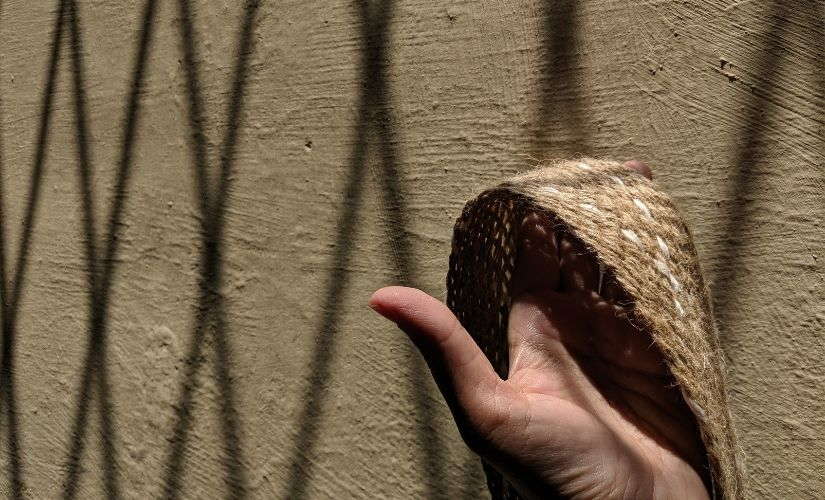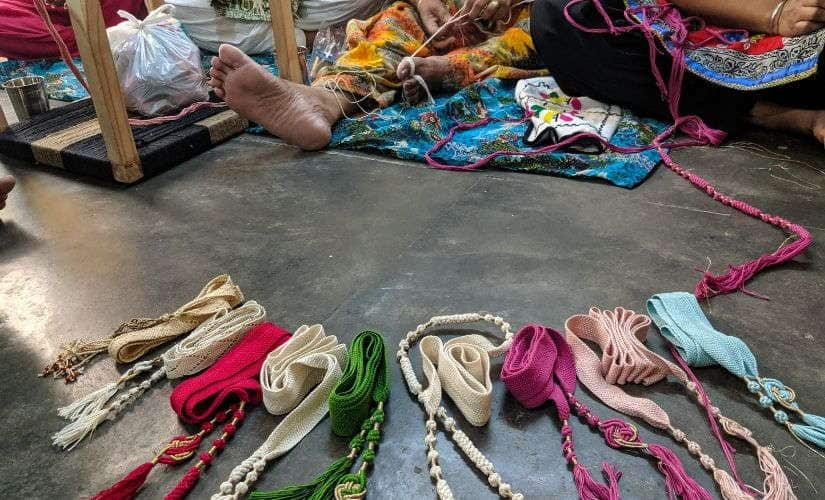When a cultural tradition is lost, it often threatens the subsequent disappearance of a way of life. While the men of Punjab fought off an unending chain of invaders, the women told their stories through art that was born inside the confines of their four walls. Punjab’s trademark Phulkari embroidery may have gained widespread recognition outside the state, but the art of making ‘azarband’, or elaborately woven nalas or drawstrings, was slowly fading out, until recently. A group of dedicated women are trying to revive the lost craft, which used to be an integral part of every Punjabi household in the past, with Project Nala Wali. The initiative is headed by Shyamli Chaudhary of Dialogue Collective, a social enterprise, who discovered it accidentally during her field visits to Punjab for CSR projects, and decided to correct the wrong by first researching old samples collected from households. She later organised and mobilised a group of women, perhaps the last ones, who knew the craft in its entirety. In Punjab, a girl’s wedding trousseau during pre-partition days would be incomplete without the beautifully woven azarbands that were gifted to relatives. For each trousseau, hundreds of nalas were woven collectively by the women of the village in different techniques and patterns. The weaving ritual had its own songs, and the weaving tools were provided by the girl’s parents as part of the daaj or dowry. The craft was handed down from one generation of women to the next, and now, several years later, the azarband is making its presence felt at the Milan Fashion Week, in its modern, designer avatar. [caption id=“attachment_6901021” align=“alignnone” width=“825”]  An azarband[/caption] Chaudhary was introduced to the craft by her teacher, Swatantar Mann, who came to India in 2008 almost after a decade. Mann lived in the US, where she worked on making cultural connections through creative learning. She wanted the handwoven azarbands, but realised how everyone, including its erstwhile weavers_,_ were settling for the readymade nalas available in the market. “No one could recollect even hearing it in common usage,” Mann says. She soon realised how the azarbands are anything but mere drawstrings — they are carriers of Punjab’s legacy as woven by its own womenfolk, whose lives are intertwined with the seemingly simple craft that is deceptively intricate. And thus began her own research on the folk art. “I used my own azarband to start a conversation with Punjabis in the US. That led to a great conversation. Even those who wove the azarband growing up threw away theirs as they did not use the handwoven ones any more,” she says. She resolved to pursue the subject and started ground work in 2015. Mann hopes to publish a paper on the art of weaving azarbands, which is still prevalent in Pakistan, Turkey, and Afghanistan. Her wish to revive the weave led her to collaborating with Chaudhary. She felt the project had potential to provide employment to women in need, and in the process, revive a piece of cultural heritage as well. *** In the village of Khuda Ali Sher located in the vicinity of Chandigarh, a lane so narrow that it can only allow a scooter to pass leads to a small room, where about a dozen women squat and weave magical patterns on nalas with colourful threads, jute and wool. The weave is old, but the patterns are contemporary. [caption id=“attachment_6901031” align=“alignnone” width=“825”]  The women at Project Nala Wali weaving the nalas[/caption] All the three regions of Majha, Malwa and Doaba of Punjab have their distinct styles of weaving azarbands, says Gomti, a 45-year-old woman who weaves brightly coloured woollen fabric on an adda or an elementary loom made of an antique wooden frame. She drapes the wool around the adda and tangles the fabric in a number of kaanas (reed) — a process spanning approximately 20 minutes. Gomti’s hands move magically in swift and rhythmic motions, and within minutes, she weaves a couple of inches of an improvised, designer nala. The adda belonged to her mother, who had received it in her daaj. The contraption has a mirror placed between the pictures of the gurus, in order to help the weaver indulge in some vanity. Only few such addas — which came with a chouki or peedha (low stool) to sit on — exist today. On my insistence, Gomti and her friends Malkeet Kaur, Rajwinder Kaur and Surinder Kaur, hum a song. It’s melodious, and talks about the drawstring that’s being strung. But who’ll open it? — the song asks. The women sing in unison with their cheeks flushing. Even the songs vary from one region to the next. “Only few women remember these songs now, most are lost with our mothers and grandmothers,” says Sukhdev Kaur, another weaver. Chaudhary and Mann collect these azarband songs as a part of their research. Malkeet has five daughters and an alcoholic husband. For unemployed women like her, their nalas travelling to Milan doesn’t make much sense, except the little financial gain they stand to make at the end of the process. It earns them self-respect, and proves to be therapeutic as well. “I am happiest when I am weaving,” Gomti says about her eleven-to-four occupation. “We knew how to recycle everything in the household — nalas were woven with left over wool, pieces of cloths and threads,” adds Sukhdev, who encourages other women to take up some work. “Instead of being called old and useless, it’s better to use our skills and earn respect,” she says. Designers Upasana from Auroville, and Manishita Gupta from Mumbai, have made artistic interventions. Gupta says that she is pleasantly surprised to see how a sound sense of design already exists in the products made at Project Nala Wali. For example, the nalas have a weave towards the end, which makes the strings stiff, thereby facilitating its insertion into the trouser or skirt without the help of a large safety pin. She is introducing these ethnic belts on Milan Fashion Week next year, with stylised wooden buckles and other design improvisations. [caption id=“attachment_6901041” align=“alignnone” width=“825”]  A traditional adda; an azarband[/caption] Vardhman, the leading brand in woollen yarn, has shown interest in their products and has consequently provided wool for the weaving of azarbands. Therefore, the _nala-_weave is now used for making chic belts, bands, stylish straps for bags and dresses, neckline trims, buttons, tassels and lace, among other accessories for home decor. Designers have been approaching Project Nala Wali to order handwoven nalas for wedding lehengas as well. “We have invested time in their training, they have skills but needed to fine tune it with changing customer demands. We ensure that when I look at a product, I shouldn’t know who has made it — each one should get similar finesse and speed," Chaudhary says. While the larger mission is to change consumer behaviour towards handmade products, the story of azarband’s successful revival brings hope to many such indigenous crafts in India that are threatened with extinction.
The art of making ‘azarband’, or elaborately woven nalas or drawstrings, was slowly fading out, until recently. A group of dedicated women are trying to revive the lost craft, which used to be an integral part of every Punjabi household in the past, with Project Nala Wali.
Advertisement
End of Article


)
)
)
)
)
)
)
)
)



